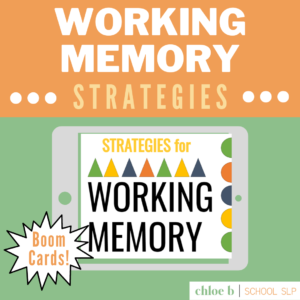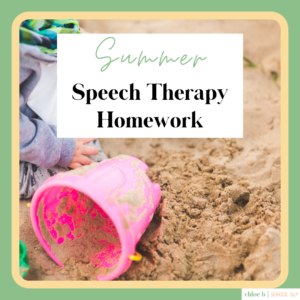Working memory is a complex aspect of memory that is crucial to academic success. Let’s explore what working memory is, and then discuss 5 activities for working memory improvement!
What is Working Memory?
To learn about working memory, we need to first understand executive functioning. Executive functioning is a broad umbrella term for cognitive processes that help us complete tasks. We use executive functioning skills constantly! Executive functioning can be broken down into planning, organization, self-regulation, impulse control, task initiation, flexibility, shifting, self-monitoring, and of course – working memory!
Working memory is a complex aspect of memory that is crucial to academic success. But what is it?
Working memory is the ability to hold information long enough in your brain to do something with it.
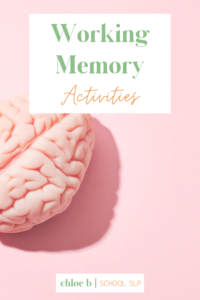
You use your working memory when someone tells you their phone number, you hold it in your brain, and then you type in all the numbers. You use it to understand the page you just read or to solve a math problem.
There are lots of strategies that you can use to support your working memory, and I’ll dive into that on a different post. This one is specifically geared to activities that you can do with children to help improve their working memory skills!
1. Play A Game That Builds on Itself
This is such a fun game to play with a group of kids! You can also play just you + the child. The game is we’re going [on a picnic] but you could also use going on vacation, going to school, etc. I like the picnic theme because it’s all about food!
Here’s how you play –
- The first person says “We’re going on a picnic and I’m bringing _______” (pick any food/drink/whatever)
- The second person says “We’re going on a picnic and we’re bringing ______ (item from 1st person) and _______(add a new item!)
- The next person repeats this by recalling what the first person said, second person said, and then adding to it!
This is a great way to challenge the child and promote growth! They were able to recall 6 items independently? Let’s do it again and aim for 7! Use different strategies to see what works best for facilitating their working memory skills! (another blog post coming soon on this!)
2. Visual Recall Games
Working memory isn’t just auditory memory. It is important to incorporate visual working memory as well! There are a LOT of visual recall games out there. Examples –
- Matching game (turn over 2 cards at a time to try and get a match)
- Spot the Difference game (especially if you show a [simplified] picture then take it away before you show the other one to see what changed)
- Show four different cards (of pictures, shapes, etc.) then flip them over. Let the child label each card then flip it over to see if they got it right. Keep adding cards to increase difficulty
3. Read Picture Books Without Showing the Pictures at First
This is a great way to build working memory skills while encouraging active listening or active reading comprehension (depending on if the child is doing the actual reading). You can’t remember something that you didn’t pay attention to.
Attention is step 1. If they’ve got that down, then you can work on building their working memory capacity.
I like to read a picture book to my students and hide the pictures at first. Then I can ask questions that promote visualization (SUCH AN IMPORTANT SKILL FOR EXECUTIVE FUNCTIONING!) like “What are you picturing?” or “What do you see in your mind?”
The child can take the words from the text, hold them in his/her mind to create an image, then use that image to describe what they are picturing = lots of working memory practice!
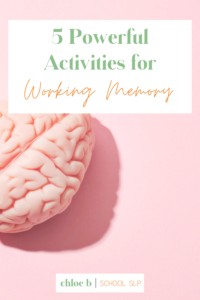
4. Play Card Games / Board Games with Rules
Depending on the child’s abilities, you can play different games with them that promote working memory skills. Simple games like Candyland or Jenga aren’t going to do the trick. You need games like Guess Who, Distraction, Spot It, etc. For older students, games like Exploding Kittens or Catan that offer complexity can target working memory as well as other crucial executive functioning skills like planning, inhibition, and self-monitoring.
5. Directly Practicing – Activities for Working Memory
Some students need more direct instruction to actually improve their memory. They need to be taught strategies explicitly. That’s why I created an online activity (through Boom Learning – accounts are free!) to target working memory!
The first deck is for TEACHING the skill using strategies such as chunking, visualization, repetition, etc.
The other deck is for PRACTICING the skill using the strategies you already learned! These can be used again and again! Plus I sell them for super cheap so they’re accessible to all!
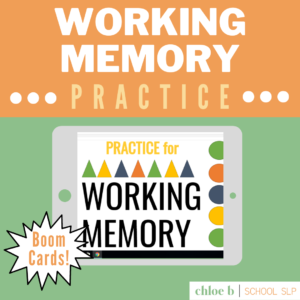
And there you have it! 5 fun activities for working memory!
What questions do you have? Let me know in the comments below! Or you can always reach out on social media!
For more info on working memory check out this blog post that discusses strategies!
-Chloe B | School SLP


